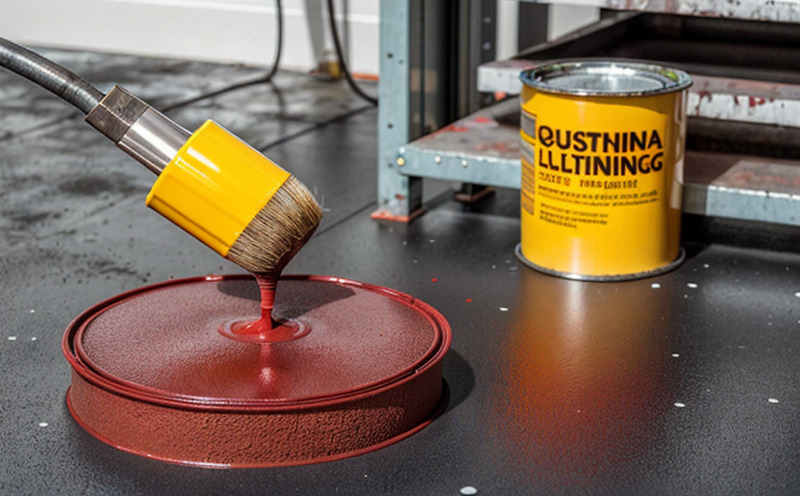ISO 2815 Buchholz Indentation Hardness Testing
The ISO 2815 Buchholz indentation hardness test is a critical method used in industrial manufacturing and processing, particularly for evaluating the mechanical properties of coatings, paints, and surface finishing materials. This test provides a quantitative measure of the resistance to localized plastic deformation, which can be crucial for understanding the durability and performance of these materials under various conditions.
The Buchholz indentation hardness method is widely used in industries such as automotive, aerospace, and electronics where the integrity and longevity of coatings are paramount. The test involves applying a defined force through an indenter to measure the depth of penetration into the coating or material surface. This measurement directly correlates with the hardness of the material.
The process begins with selecting a representative specimen, typically from industrial manufacturing samples or finished products. Specimen preparation is crucial for accurate testing; it requires ensuring uniform thickness and free from defects that could skew results. The test can be conducted on various types of surfaces including metal, plastic, and composite materials, making it versatile across different sectors.
The force applied during the indentation process must adhere strictly to ISO 2815 standards to ensure consistency and reliability of results. Instruments used for this purpose include specialized hardness testers equipped with a controlled load cell that measures the depth of penetration accurately. The depth is then converted into hardness values using specific formulas defined in the standard.
Understanding the implications of these tests for quality assurance is essential. Hardness testing helps manufacturers ensure compliance with industry standards and customer expectations by validating the robustness of their products. It also aids in troubleshooting issues related to coating failures or premature wear, allowing for timely corrective actions.
In addition to its application in industrial settings, Buchholz hardness tests are increasingly important in research and development environments where new materials and coatings are being introduced. By providing precise hardness data, these tests support the optimization of formulations, enhancing product performance and reliability.
For quality managers and compliance officers, incorporating Buchholz testing into their processes ensures adherence to international standards while also offering valuable insights into material behavior under stress. R&D engineers benefit from this detailed assessment in formulating materials that meet both functional requirements and rigorous industry benchmarks.
The results of these tests are typically reported as indentation hardness values which can be compared against baseline data or competitive products. This comparative analysis helps in identifying strengths and areas for improvement, guiding strategic decisions regarding product development and quality control measures.
Given the importance of this test across multiple industries, it's clear that mastering ISO 2815 Buchholz Indentation Hardness Testing is not just beneficial but necessary for achieving excellence in industrial manufacturing and processing. By adhering to these stringent protocols, organizations can ensure they are delivering high-quality materials capable of meeting challenging operational demands.
Applied Standards
| Standard | Description |
|---|---|
| ISO 2815:2016 | Determination of indentation hardness of plastics by means of the Buchholz method. |
| ASTM D747-19 | Standard Test Method for Hardness of Plastics by Means of an Indentor and a Load Apparatus. |
| EN ISO 2815:2016 | Determination of indentation hardness of plastics by means of the Buchholz method (equivalent to ISO 2815). |
| IEC 62392-4:2017 | Test methods for determining the mechanical properties of electrical and electronic components - Part 4: Hardness tests. |
Quality and Reliability Assurance
The ISO 2815 Buchholz indentation hardness testing plays a pivotal role in ensuring the quality and reliability of industrial coatings, paints, and surface finishing materials. By adhering to stringent standards like those outlined in ISO 2815:2016, manufacturers can maintain consistent product performance across various environmental conditions.
Quality assurance through this method involves several key steps that contribute to overall reliability:
- Specimen Selection: Careful selection of specimens ensures they represent typical industrial applications accurately.
- Preparation: Proper preparation minimizes variability and provides a stable foundation for accurate measurements.
- Instrumentation: Use of calibrated instruments guarantees precise force application and depth measurement.
- Data Analysis: Comprehensive analysis allows identification of trends and outliers, facilitating informed decision-making.
The process not only enhances internal quality control but also supports external validation necessary for regulatory compliance. Compliance officers can leverage these tests to demonstrate adherence to international standards, thereby building trust with customers and stakeholders.
Moreover, the insights gained from this testing contribute significantly towards reliability engineering efforts. Engineers can use hardness data to predict wear rates, optimize material selection, and enhance overall product durability. This proactive approach is especially beneficial in sectors where high-performance materials are critical for safety and operational efficiency.
International Acceptance and Recognition
The ISO 2815 Buchholz indentation hardness test enjoys widespread international acceptance across various industries due to its robust methodology and consistent results. Its recognition is particularly notable in sectors reliant on high-performance materials where precision and reliability are paramount.
Many global standards bodies, including ASTM International and the European Committee for Standardization (CEN), have adopted ISO 2815 as a foundational document for hardness testing of plastics and other materials. This harmonization ensures that results obtained from this test can be universally understood and compared across borders.
In practice, compliance with these standards is crucial for industries involved in international trade. Companies seeking to export products must ensure their quality meets global expectations, which often includes demonstrating conformity with ISO 2815. This approach fosters trust among buyers and strengthens market access opportunities worldwide.
The test's acceptance extends beyond mere regulatory requirements; it also serves as a benchmark for innovation in material science. By adhering to these standards, manufacturers can demonstrate their commitment to excellence, opening doors to advanced research collaborations and cutting-edge technology development.





